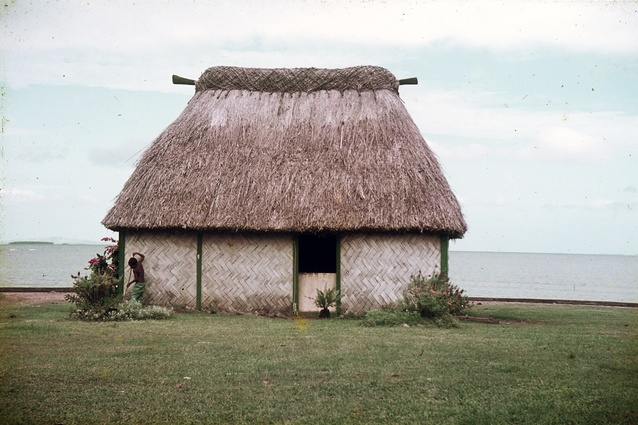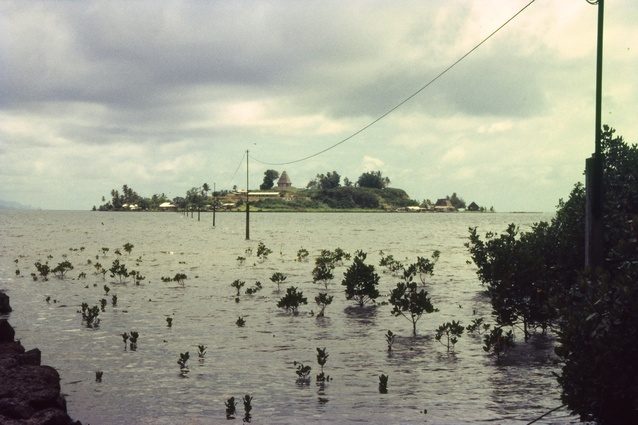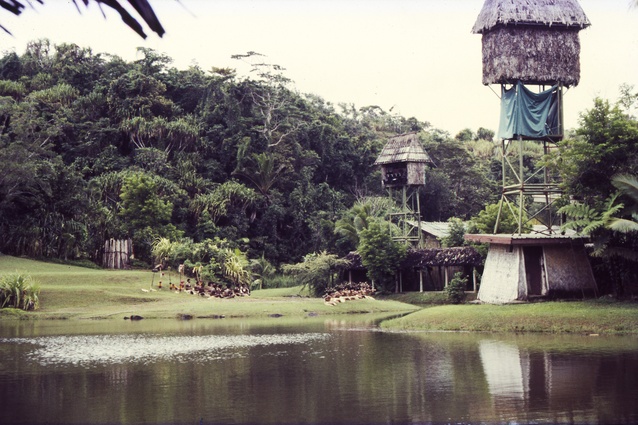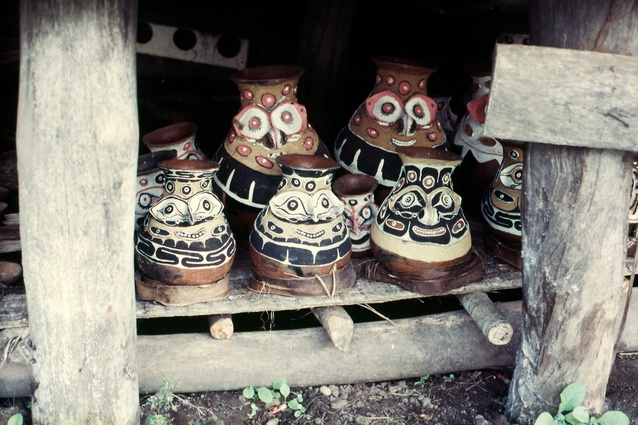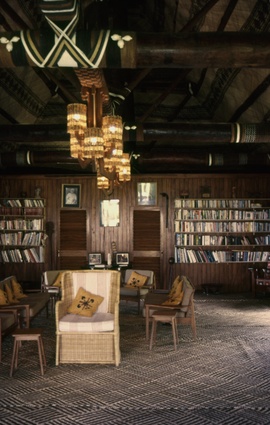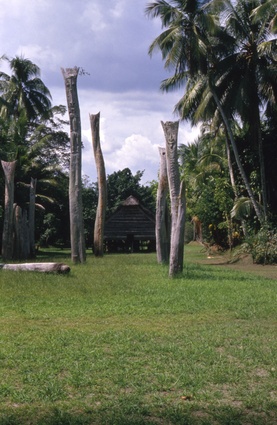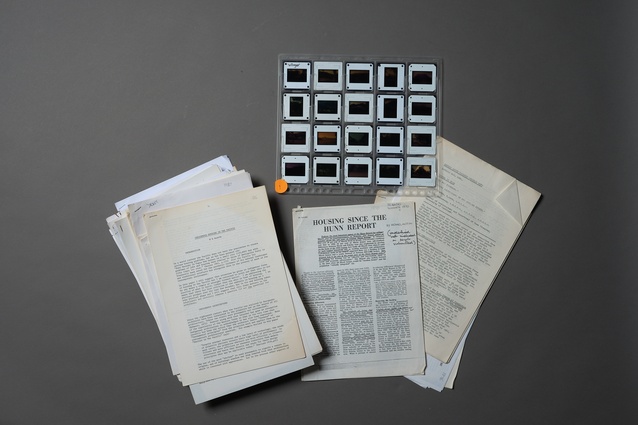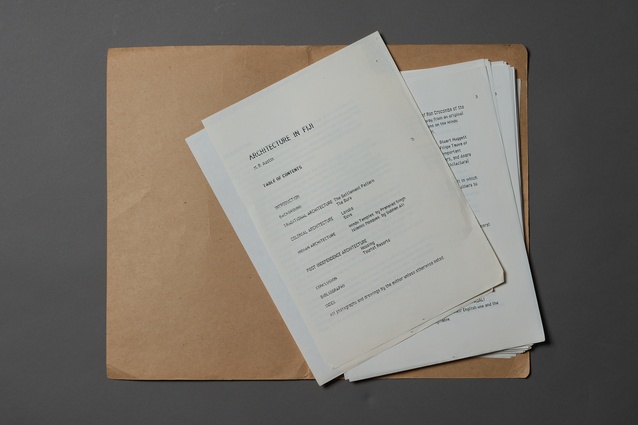Objectspace presents Mike Austin’s photographic archive Oceanic Architectural Routes
On Friday 2 December, Objectspace will open a major new architecture exhibition presenting the photographic archive of renowned architect and academic Mike Austin. Ahead of the show’s opening, curator Albert L. Refiti shares his thoughts on Austin’s legacy.
Oceanic Architectural Routes presents the photographic archive of Mike Austin – more than 1000 images taken during his travels in Papua New Guinea, Solomon Islands, Fiji, Samoa, Tonga, the Cook Islands, Hawai‘i and Rapanui from the late 1960s through to 2006.
Mike Austin’s PhD thesis Polynesia architecture in New Zealand (1976) is a landmark study of Māori and Pacific architecture. In his travels of Polynesia in the late 1960s through to the mid-1980s, when he was Head of the Architecture Department at Unitech Papua New Guinea, Austin took photos and measurements of some of the traditional buildings in the area. They have now become an important record of traditional building forms remaining then but which have since disappeared.
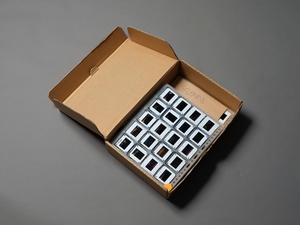
Until now, these archival images have lived within Austin’s personal slide collection, informing his significant contribution to architecture education and practice, but remaining publicly unseen. This will be the first time these images have been shown publicly.
These photographs formed the basis for Austin’s architectural anthropology studies of house forms and cultures in the Oceanic region. They were also the primary source materials for his popular courses ‘Oceanic Architecture’ and ‘People and Environment Studies’ at the University of Auckland’s School of Architecture from the 1980s until 1999, and in his later work as a supervisor of Pacific Master of Architecture students at Unitec and the University of Auckland.
The images and ideas seeded by Austin’s Oceanic architecture lectures quietly sprouted alternative roots in contemporary New Zealand architectural history. Some of these roots became routes, to borrow a metaphor from anthropologist James Clifford – they enabled Pacific architectural customs and knowledge to connect with the vast reservoir of Indigenous knowledge worldwide, leading to the burgeoning interest in Pacific/Moana and Māori architecture today.
In Austin’s teaching, roots and routes are not separate but, rather, are entangled threads, continuities in transformation that are “rewoven and repeated”1 in his studies, photographs and architectural practice. Numerous examples of this cut through this exhibition – from Austin’s studio teaching and the birth of the experimental pilot school The Brick Studio at the Auckland School of Architecture in the 1970s; the rerouting of architectural anthropology via ‘Oceanic Architecture’ in the 1980s; and the weaving together of critical theory, Pacific architectural modernity and Indigenous knowledge from 2000 onwards. Plans for the exhibition spurred on the digitisation of Austin’s archive, enabling future opportunities for the photographs to circulate and educate.
It is not surprising that for Austin, an experienced sailor, architecture in the Pacific is intimately connected to both land and sea – the land for roots to take hold in, and the sea for routes of ideas and relationships to extend and connect.
Exhibition details
Private preview: 6pm, Thursday 1 December 2022
Opening: 6pm, Friday 2 December 2022
Exhibiting: 3 December 2022 – 26 February 2023
Objectspace, 13 Rose Road, Ponsonby, Auckland
Dr Mike Austin, practitioner
Austin has made a significant contribution in the research and understanding of buildings, architecture and culture of Oceania and the Pacific. Austin began teaching at the University of Auckland School of Architecture in 1969 after working in the architectural office of Newman, Smith & Greenough. His PhD in 1976 supervised by Gerhard Rosenberg, Polynesian Architecture in New Zealand, was the first serious study of Māori and Pacific architecture. From that time Austin has focussed on a syntactical understanding of the language and development of architecture in the Pacific region. He taught from 1969 until 1999 at the University of Auckland and was Head of Architecture at Unitech Papua New Guinea in 1987 before taking a position as Professor of architecture at Unitec in 2000.
Albert L. Refiti, curator
Leali’ifano Dr Albert L. Refiti (Samoa: Fasito’outa, Vaovai, Vailima) is Associate Professor of Art and Design at Auckland University of Technology. He is co-editor of The Handbook of Contemporary Indigenous Architecture (2018) and Pacific Spaces: Translations and Transmutations (2022). He is a co-leader with Tina Engel-Schwarzpaul and Layne Waerea of the Vā Moana Research Cluster at AUT University and is currently conducting research funded by the Royal Society Marsden Fund on the history of architecture in Te Moananui with Rau Hoskins.
Hannah Manning-Scott, exhibition designer
Hannah Manning-Scott is an exhibition designer with a Master of Architecture (M.Arch.) (Prof) from the University of Auckland. She has designed major exhibitions for Auckland Art Gallery Toi o Tāmaki over the last seven years. Hannah is uniquely placed to position this photographic archive through design as she is the daughter of Dr Mike Austin, and begun the development of this programme when she reached out to Objectspace about making Austin’s extensive archive available to the public.
1 James Clifford, Returns: Becoming Indigenous in the Twenty-First Century, Harvard University Press, 2013. Clifford originally used his roots/routes metaphor to describe the legacy of Epeli Ha‘uofa.

